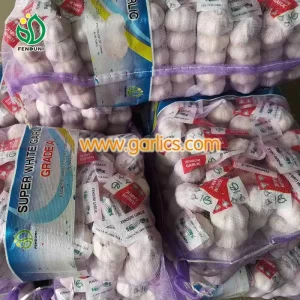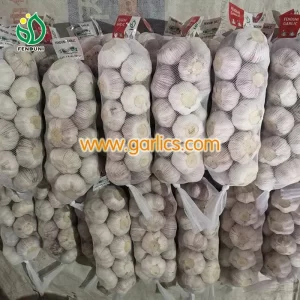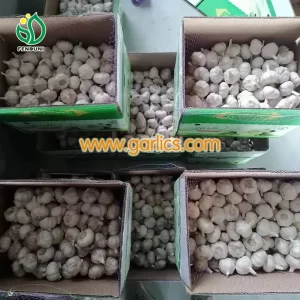Garlic is one of the most important ingredients used in cooking. It is an edible bulb from the lily plant family. Garlic, especially Chinese garlic, is used around the world. China is the worldwide leader in garlic production as the country produces around 75% of all the garlic in the world; India, Korea, and the United States rank 2nd, 3rd, and 4th accordingly.
Types of Garlic
The common types of garlic are hard neck garlic and soft neck garlic. Among other important types of garlic are elephant garlic and purple garlic. Let’s discuss them all one by one.
Hard Neck Garlic Vs. Soft Neck Garlic
The hard neck garlic has a woody stalk at the center. It has a ‘neck’ at the top of each clove, and you need to remove the neck to remove skin or chop. The hard neck garlic has fewer generally bigger cloves.
In contrast, the soft neck garlic doesn’t have a wooden stalk at the center. Soft neck garlic cloves are smaller and generally come with more cloves than hard neck garlic.
The hard neck garlic is more flavorful and tastes slightly better. It is also more resistant to cold and can be stored for longer.

Elephant Garlic Vs. Garlic
The elephant garlic draws its name from its big size. It is almost twice the size of regular garlic. For example, if you check elephant garlic vs. regular garlic, the elephant garlic will be double the size and weight.
Elephant garlic was exported to the USA from Italy. It is also called buffalo garlic. It is easy to peel but it is hard to grow in the cold conditions.
Elephant garlic belongs to the onion genus. When comparing elephant garlic vs. garlic used daily in cooking, the elephant garlic gives a milder, mellow taste, similar to the onion taste.
Elephant garlic is more suited for roasted garlic dishes. It can also be eaten raw.
You can find elephant garlic for sale in your local farmers market or the produce section of a supermarket.
If you are interested in buying a bulk quantity of elephant garlic for sale in your local country, contact us today for a free quote.
Elephant garlic vs. garlic nutrients is not that much different. Both vegetables are rich in vitamin E, vitamin C, vitamin A, vitamin B9, calcium, and dietary fiber.

Purple Garlic
Purple garlic is the name of the garlic type that has purple papery skin. Garlic looks purple, but the purple garlic cloves are like regular garlic cloves in color and taste.
The purple comes in both hardneck and softneck garlic types. The purple garlic cloves are mostly off-white with the same taste as regular garlic.
If you see purple garlic cloves in the garlic, which didn’t come with the purple skin, your garlic may have rotten and may not be usable. The shelf life of garlic is about one month, so keeping them longer might not be a great idea.
How to spot the best garlic?
The definition of the best garlic is not fixed. The best garlic for different types of cooking is widely different.
The garlic we use daily is good for increasing flavor but it is not the best for roasting. Similarly, elephant garlic is considered the best garlic for roasting due to its mild flavor, but it is not great for enhancing flavor.
- Check Freshness: The best garlic is fresh and spotless.
- Smalls Nice and Strong: The garlic smell tells you whether it is good.
Garlic stays nice in the refrigerator for about a month, but you can store it outside the refrigerator for a few weeks only. We can say that you can buy one month’s supply when you do monthly groceries.
Pre-peeled garlic is available in the market, which you can use to save time, though peeling still doesn’t take much time and gives a fresh flavor to food.
For storing garlic in your kitchen, use mesh bags or spread garlic. Store garlic in a dry place with an average temperature of 15-18 centigrades.
Busting Myths and Propaganda about Chinese Garlic
You will find a great amount of propaganda about Chinese garlic online. There are conspiracy theorists who won’t present science to support their claims. Fortunately, the scientists don’t back these conspiracy theorists.

We have debunked some of the top myths and conspiracy theories about the Chinese garlic you find online, read on to know more.
Myth #1: Chinese garlic is grown in the sewer:
China is the largest producer of garlic. It produces about 75% of all the garlic grown in the world. First, growing this much garlic in the sewer is practically impossible. The farmland under garlic farming is really huge. For reference, one hectare of farmland produces about 3000 kilograms of garlic.
Second, see how McGill has debunked the myth and propaganda about the Chinese garlic being grown in the sewer. Read the full report of McGill here.
Myth #2: Chinese garlic has pesticide and heavy metals contamination
Another myth to stop high-quality and cheap Chinese food from entering the market is to say that it is contaminated with pesticide residues and contaminated with heavy metals. Clearly, these conspiracy theorists didn’t study in high school.
Let’s hear it from the horse’s mouth.
The European Union Parliament asked the same question from their authorities; their answer states that there was no evidence of harmful pesticide residuals in garlic. Also, the Chinese garlic is not bleached. You can find some spots on the garlic which shouldn’t have been there when it was bleached.
Myth #3: Chinese Garlic Comes without Roots
All export orders are prepared as per the customer’s requirements. When customers request the roots to be removed, the garlic is exported without roots. So, when you see a rootless garlic bulb, it is not sure if it is Chinese or not.
The garlic is washed properly, and the roots do not carry soil-borne diseases.
Chinese Garlic Wholesale
China is the largest and most reliable producer of garlic. Fenduni has elephant garlic for sale for all bulk orders from around the world, hard neck garlic for sale, soft neck garlic for sale, and purple garlic.
Fenduni is located at the heart of the garlic production area in Jinxiang, China. We have our own plating base with over a dozen points of purchase and cold storage. We export more than 60,000 metric tons of garlic every year.
In China, there is spring sowing and autumn sowing of garlic. We usually harvest garlic in May and June of each year. There is some variation in the sowing and harvesting of garlic as the soil and weather conditions change. Most of the process is mechanized.
We offer a range of packing options in different bags. You can buy garlic in ready-ready packing of 100g to 1000g, or you can buy it in bigger bags like 4 kg to 50kg for selling to other businesses and in the market.
Check our garlic wholesale prices or request a free quote for your order with us.
Wholesale Garlic Prices
The garlic wholesale prices partly depend on the order size, garlic type, and other details. Rest assured, our prices are very competitive, and we can customize your order as per your specifications.
How to Buy and Import Chinese Garlic

This is a short, step-by-step guide on the process of importing Chinese garlic.
Step 1: Check for Govt Regulations
Many countries have placed a quota for the import of food items. Check with your local authorities to know about the quota and how you can get a share for importing garlic.
These countries are the largest importers of garlic in the world. All of these countries have some kind of import quota system for food import.
- Indonesia
- Vietnam
- United States
- Brazil
- Malaysia
- Germany
- France
- Thailand
- Italy
- Pakistan
Step 2: Check the Economic Viability of the Import
Due to the production economy of scale, Chinese garlic will almost always be cheaper than your local garlic. However, see how you will sell the imported garlic. Once you know you can sell your import and it will be profitable, proceed to the next step.
Also, keep in mind that food items have a low shelf life. You will need to put it into cold storage or sell it to the market rather quickly.
This guide will help you understand import market dynamics and how you can make sure your import will be profitable.
Step 3: Get a Custom Quote for your Garlic Import from Fenduni
Fenduni is your reliable business partner when it comes to buying wholesale Chinese garlic. Visit our product catalog page and request a custom quote for your order. Our representatives will be in touch soon.
Step 4: Finalize the Deal
Once we discuss the details like garlic type, quantity, price, packing, shipping, payment terms, and lead time, we can prepare your order.
Step 5: Grow your Business and Make your Mark
You can start small, or you can capture the market. Start with the first order to import and see how quickly you can scale your business with an exceptionally economically viable produc
